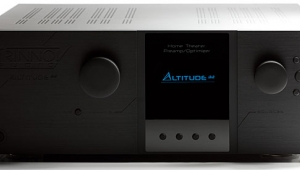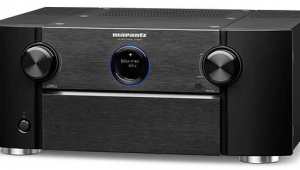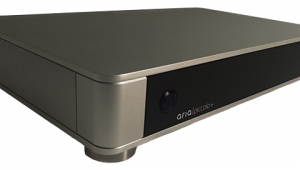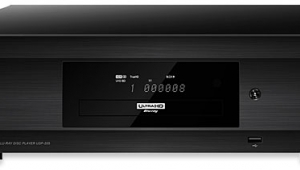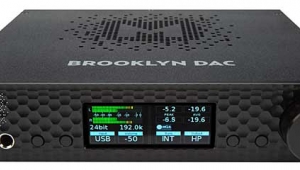| Columns Retired Columns & Blogs |
Music in the Round #26
The great format battle of our time continues to rage between the Blu-ray and HD DVD camps. For many reasons, some discussed in the July installment of this column, this battle may be the last one waged over physical media formats. But whether either or neither format wins, the outcome will be decided on the basis of video quality—issues of audio quality are being ignored. This is unfortunate for audiophiles for two reasons. First, we have a big stake in whatever will be the standard medium for movies and music, but second, this battle makes it apparent that the major forces in the marketplace are ignoring what matters most to us.
Footnote 1: Shane Buettner of www.ultimateavmag.com pointed out subsequent to publication of this column that the Pioneer player has received a firmware update that allows it to decode Dolby TrueHD, which is transcoded to linear PCM and sent out over the HDMI connection.—John Atkinson
Sure, Dolby Labs and DTS have come up with the new lossless, high-resolution, multichannel CODECs of Dolby TrueHD and DTS-HD Master Audio. But most of the first generation of high-definition players can't take full advantage of these CODECs because they lack the capacity to decode them fully, and/or because they lack the firmware to allow the HDMI interface (the latest specification is 1.3) to transmit them to a capable processor—and few of the hi-def discs released so far contain such audio tracks to begin with. This accurately reveals how important high-quality sound is to the movers and shakers of the industry: not very. It's as if, after watching the SACD and DVD-Audio camps fight to a Pyrrhic victory, they've concluded that no one cares about good sound.
Well, I care. I tried for nearly a year to get my hands on an HD player, whether Blu-ray or HD DVD, from any manufacturer, but each request elicited a polite response that I would be put on a list and would be sent a player when one became available. Of course, I could buy one, but at this point I can't justify such a purchase. (More about that later.) So I leaned on the goodwill I now have at Pioneer, following my glowing review of the Pioneer S-1EX loudspeaker in the March issue (as if that review was not fully earned), and asked Andrew Jones to help. He contacted the right people, and I was sent a Pioneer Elite BDP-HD1 Blu-ray player (street price $1300–$1500).
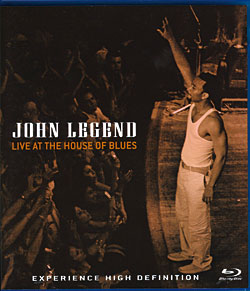 Putting aside Blu-ray's admittedly seductive visual quality—discussed at length, and with greater insight, in our sister publications Home Theater and UltimateAVmag.com—the BDP-HD1 can output audio signals in a number of ways: via S/PDIF coax, TosLink, two-channel RCA analog, 5.1-channel RCA analog, and HDMI. Scratch the first three, which can't convey multichannel hi-rez audio. And scratch HDMI as well—like many first-generation HD players, the BDP-HD1 was rushed to market before an interface that could handle all HD audio formats was made available (footnote 1). So I was left in familiar territory with 5.1 analog interconnections, much as we'd been for so long with SACD and DVD-A. The good news is that some Sony Blu-ray discs are said to have a 5.1-channel, hi-rez, LPCM audio track that is ideally suited for audiophiles, although I don't know if Sony, in its finite wisdom, recognized this as an issue.
Putting aside Blu-ray's admittedly seductive visual quality—discussed at length, and with greater insight, in our sister publications Home Theater and UltimateAVmag.com—the BDP-HD1 can output audio signals in a number of ways: via S/PDIF coax, TosLink, two-channel RCA analog, 5.1-channel RCA analog, and HDMI. Scratch the first three, which can't convey multichannel hi-rez audio. And scratch HDMI as well—like many first-generation HD players, the BDP-HD1 was rushed to market before an interface that could handle all HD audio formats was made available (footnote 1). So I was left in familiar territory with 5.1 analog interconnections, much as we'd been for so long with SACD and DVD-A. The good news is that some Sony Blu-ray discs are said to have a 5.1-channel, hi-rez, LPCM audio track that is ideally suited for audiophiles, although I don't know if Sony, in its finite wisdom, recognized this as an issue.
Awaking the BDP-HD1 takes what seems like five minutes, and loading a disc evokes the obligatory noisy marquees, FBI messages, and menus on the video display. That might not seem like much when watching a film whose duration is measured in hours, but it's annoying to have to sit through all this just to listen to one or two tunes from a music disc that together last only 10 minutes. Next are the navigational impediments, inherited from standard-definition DVD, in selecting the audio format you prefer. It's not that this procedure has to be complex, but producers seem to find ever more creatively obscuring ways of designing these menus. So, strike one against Blu-ray as a music medium. In defense of the Elite BDP-HD1, it let me get to the music much more quickly: I could simply hit Play, then use the remote control's Track and Audio buttons to select from those menus while the disc was playing.
Other disappointments included the lack of repertoire now available (not surprising for a new medium), and the inconsistent range of the audio options. For example, there's a much-ballyhooed HD DVD of Tchaikovsky's Swan Lake (Opus Arte OA HD5001 D) that is no doubt beautiful to watch, but the audio options are so 20th-century: 2.0- and 5.0-channel, 24-bit/48kHz DTS. Of the six or seven music HD discs I bought, only one had a hi-rez multichannel PCM track, some had two-channel hi-rez PCM, though all had various flavors of Dolby and DTS. But I discovered this only via the onscreen menus—on the jackets of these discs, the audio information is printed in the smallest type font, and in a color with the least contrast to the background.
That's the bad news. The good news is that, despite the apparent lack of attention paid to audio, the sound on these discs was excellent, if not uniformly so. Most impressive was John Legend's Live at the House of Blues (Blu-ray, Columbia 82876 87279 9), because it was the only one with a hi-rez 5.1 LPCM track. Sure, it's the now-familiar large-club perspective with too much ambience and audience sound, but the engineers kept the performers in a cohesive up-front perspective, and were subtle in their highlighting of individuals. The result is a pretty good rendering of such an event. That comes through in Dolby Digital too, of course, but the 5.1 LPCM track offers notably more clarity and better delineation of the tonal flavors of the voices of Legend and his band. By contrast, the DD track is bright and lacking in inner detail. Two-channel stereo was much more flat and dull than either 5.1 medium, but retained some of the 5.1 LPCM track's distinctive clarity.
It's no surprise that uncompressed audio sounded better than a lossily compressed medium, but I found it strange that, in many cases, the DTS-HD track was superior to regular DTS, even though the BDP-HD1 was capable of only 16-bit/48kHz output from DTS-HD. DTS had distributed two different DTS-HD demo discs at the 2007 Consumer Electronics Show, so I was able to compare the DTS-HD tracks by Omar Hakim and by Peter Gabriel with the otherwise identical DTS tracks on DTS's 2006 demo disc, Alive! In both cases the differences were similar to, if not as great as, the differences between the plain-vanilla DD and uncompressed PCM tracks on the Legend disc. In particular, the sheer impact of the opening of the Omar Hakim selection was similar in DTS and DTS-HD, but the greater clarity of the latter version was easy to hear.
The message is clear: The advantage of the lossless, higher-resolution audio tracks is audible even through less than optimum hardware. This can be best realized with Ramsey Lewis' Legends of Jazz Showcase (Blu-ray, LRS Media 090005 BDWR), probably because it was produced to showcase the medium more than the talent (footnote 2). You might think it strange that I would pick this disc, which lacks a multichannel LPCM track, and whose Dolby TruHD track can be output only as 16/48 by the BDP-HD1 (footnote 3). That's still better than CD in sampling rate and number of channels, and, unlike the regular DD track, Dolby TruHD is losslessly compressed. This disc's excellent miking, mixing, and mastering (the true 3M of the recording industry) conveyed excellent detail, realistic ambience, precise imaging (as compared to what I could see of the actual stage onscreen), and a satisfying tonal balance. I wouldn't say that Legends of Jazz Showcase has some of the very best recorded jazz sound I've heard, but I'd be immensely grateful if this were what we could expect as standard issue from the new hi-rez media. Hey, with the newer players being able to decode and transmit the full bandwidth of HD audio formats, those media will sound even better.
I found all of this very encouraging. I could easily hear the improvement in sound of the higher-resolution tracks, which lacked the tonal compression and grain I usually hear from the lossy DD and DTS media. Still, on the basis of this limited experience, it would be hard for me to justify buying a Blu-ray or an HD DVD player. Too few music discs are available, and there is no certainty of when we will see more titles, or what they will be. There are film titles galore, of course, but you must still choose a player based on what repertoire is available in which format.
Footnote 1: Shane Buettner of www.ultimateavmag.com pointed out subsequent to publication of this column that the Pioneer player has received a firmware update that allows it to decode Dolby TrueHD, which is transcoded to linear PCM and sent out over the HDMI connection.—John Atkinson
Footnote 2: The program is fairly diverse and includes many familiar talents, but most of these great performers seem to be too much on their best behavior. Less premeditation and decorum and they might have swung a bit more.
Footnote 3: This suggests that 16/48 was the true resolution of the tracks. In theory, TrueHD preserves the original resolution of the master, ie, if was 24-bit/96kHz, that is what would be output once the data were transcoded.—John Atkinson
- Log in or register to post comments


